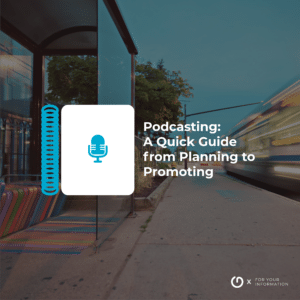
Podcasting is super hot right now — and listenership is strong and growing. Many people find it easier to consume information by listening to a podcast rather than reading or watching a video containing the same information.
With an affluent and educated listener base, this medium could be a great way for you to highlight your experience and position yourself or organization as experts in your industry. This is especially true if you enjoy and find it easy to have conversations with new people.
The most successful podcasts that we’ve been a part of are ones where the hosts have fun with the process. This shines through in the final product, making it a rewarding experience and effective marketing tool.
Read on for actionable tips if you’re considering creating a podcast for your business.
Planning your podcast
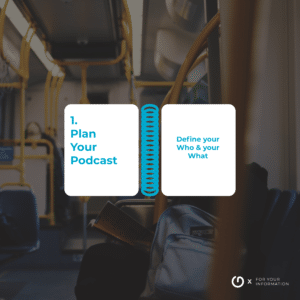
Think about the Who and What
- Identify your target audience. Think about who you are marketing to — who you hope will enjoy your podcast.
- Determine the overall subject of your podcast. Keep your target audience in mind, and decide what you will focus on for the podcast series.
- Think about how broad or narrow your niche will be. You may choose a very specific niche within your industry — or you can go very broad and have a slightly different sub-focus during each episode. Make sure that you pick something that you will find interesting to talk about in various ways throughout your podcast.
- Decide whether or not you want to have guests on your podcast. Some podcast hosts choose to talk to their audience solo. Other podcasts invite guests who are also experts in the industry to be interviewed or even co-host.

Determine the show format and style
- Length of episode – There’s no golden rule on show length. Generally speaking episodes of 30 minutes or less tend to perform better than longer episodes, but the “right” length should be dictated by the availability of quality material. If visitors get bored or don’t hear the value they’ll drop off much sooner. Listeners will continue to listen to longer shows if they find it entertaining or valuable.
- Frequency of new episodes – The key is to stay consistent so that your audience knows when to expect new material and sees you as a professional.
- Create a production calendar.
- Mark down the release dates sixty days in advance.
- Keep the calendar up-to-date.
- Scripting of discussion – Some podcasts are more scripted than others, but do what feels most natural and effective to you. You will definitely want some sort of plan going into recording so that you avoid awkward silences.
- Plan the ideal flow of your episodes – This includes things like how you will introduce guests, the body of the show, what type of summary and call to action will you include at the end.
Once you settle on a format, make a note of it so you can refer back to it as you record episodes. It may look something like this:
Sample Podcast Show Format
- Introduction – host welcomes the audience and introduces today’s guest and tells a little bit about what to expect in today’s episode
- Body – actual interview with the guest (questions planned before-hand and submitted to the guest in advance)
- Outro – host gives a quick recap of the interview, adds final thoughts and possibly promotes the next episode
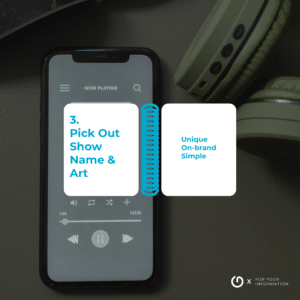
Pick out the show name and create the show art
-
Podcast Name
-
- Search for duplicates to ensure you pick a unique name
- Be clear and concise
- Practice saying it out loud
-
Podcast Cover Art
-
- Create something simple and eye catching
- Be on point with your brand
Launching your podcast
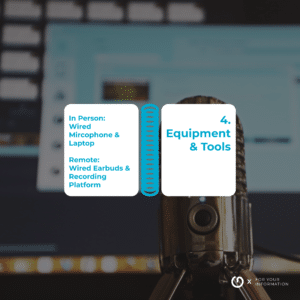
Equipment and Tools
Unless the format or style of your show is formal, you can keep equipment and production resources to a minimum. Podcasts, for the most part, are casual affairs. Think of it as a simple interview or relaxed conversation. The goal is to capture a clear recording but not necessarily sound-studio quality audio files. You can be successful with basic equipment.
-
- For in-person interviews and solo host recordings, all you need is a decent microphone and a laptop, tablet or smartphone for recording. We recommend sticking with wired microphones. Bluetooth microphones are sometimes unreliable.
- For interviews where the host and guest will be in different locations, try online recording platforms like Squadcast, Zencastr or Cast. These apps make it easy to connect with your guest and to record quality audio. They are as easy to use as a Zoom call. The host and guest should each have their own wired microphone and headset. Simple wired earbuds on a phone work well and are enough for most podcasts.
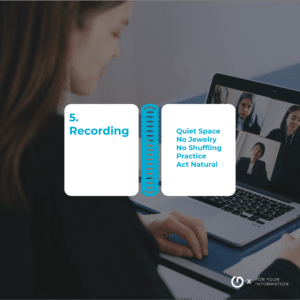
Recording the Show
- Find a quiet place free of distractions. An ideal spot doesn’t echo and has minimal ambient noise such as air flowing through AC vents or other subtle noises. Keep in mind that jewelry, and flipping through papers may be noticeable in the recording, so keep those at a minimum.
- Try a test recording to confirm the quality of your location and equipment. Keep in mind that you are not trying to achieve sound studio quality results, just clear enough to easily follow conversations.
- Start off by interviewing a friend or family member for practice.
- Test out and get used to the equipment and software. Get comfortable with hearing your own voice. Don’t be too critical. Podcasting is not a place for perfectionism. This will help you move quickly into recording “real” episodes.
- Treat “real” episodes the same as you would any other in-person conversation. If you make a mistake, say the wrong thing, or forget to mention something important, just say so and correct the information as soon as you realize the issue. Don’t count on complicated edits after the fact to make it work.
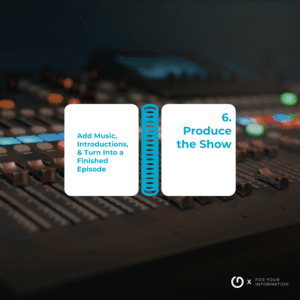
Producing the show
Turning your raw recording into a finished podcast episode can range from simple to a complex affair. If you are fairly tech savvy, have time to spare and have reasonable expectations for the finished product, you can probably edit and produce your own episodes. There are many software apps and tools out there to help.
For most of us it’s a better use of our time to bring in some help.
A professional podcast producer can quickly turn your raw files into something that sounds amazing. A producer can help you record an intro and outro and select royalty free music to use as a soundbed. A professional producer can also help clean up the occasional hiccup in an interview or technical glitch. Once the intro, outro and similar pieces are set up, producing subsequent episodes is relatively quick and easy.
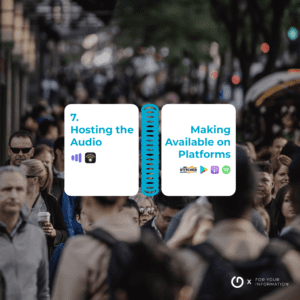
Hosting the audio files (the server type, not a person)
Once your episode is produced you will need a place to host the finished audio file. Podcast hosting services do just that. They store the actual finished podcast episode audio files and make them available to the various distribution channels such as iTunes, Google Play and Spotify.
We suggest using Megaphone and Podbean to host your podcast.
Making your show available to listeners
The next step is to make your podcast available on the common podcast distribution networks.
These are the platforms that listeners use to find, subscribe, and listen to shows. A couple of the big ones are iTunes, Google Play, Stitcher and Spotify. Each of these platforms have built in audiences who are potential listeners to your show.
You will need to set up accounts on these networks and link them to your podcast host (Megaphone, Podbean, etc.). Once connected, your podcast host will automatically push episodes to the distribution networks once a new episode is added.
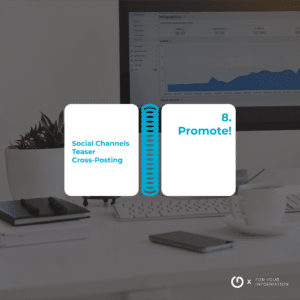
Promote your podcast
Congratulations! At this point you’re ready to start promoting your awesome new podcast.
Use your existing marketing channels to promote your new podcast. Incorporate the podcast and episode releases into your overall marketing plan and efforts.
Definitely use your social media accounts to promote it.
- Tease a future show via social.
- Then post again when it has been released.
- If you have guests on your show, ask them to promote it on their social media channels.
- Your guests social media contacts are a built in audience for that particular episode and very well may become subscribers to your show and followers of your social media channels.
- Depending on the topic of your show and desired audience, paid advertising may be an effective way to build listenership. For example, LinkedIn advertising can be a great way to economically reach targeted business audiences.
Gray Digital Group can help!
We’ve produced dozens of podcasts and hundreds of episodes. We’re here to help. Connect with us to discuss podcasting and how it may fit into your broader digital marketing strategy.
